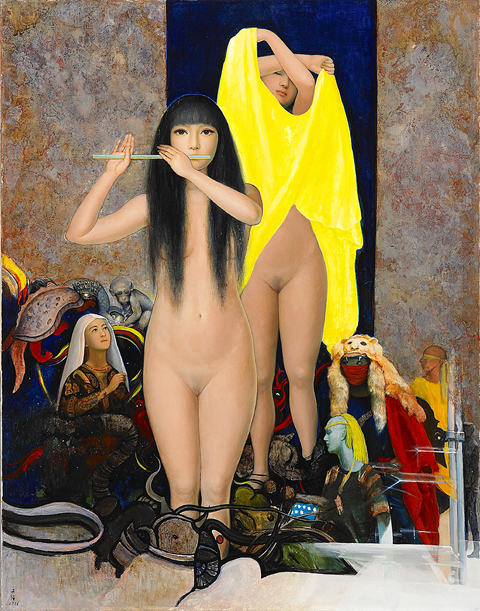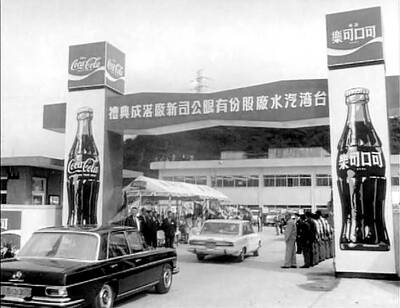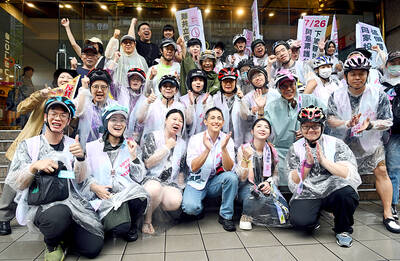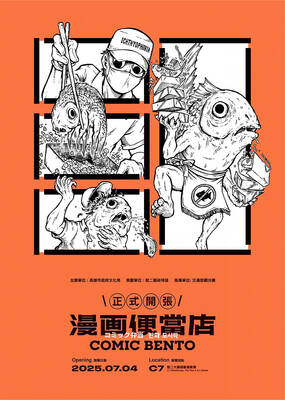Taipei’s gallery and museum scene has become transfixed on young artists who work in a variety of media, are technically competent, take inspiration from global culture and blur the boundaries between installation and more traditional forms of art. Metaphysical Art Gallery refreshingly veers to the latter with Truly Hero, an exhibition of the work of nine Taiwanese artists, all born between 1945 and 1955 and who work mostly in acrylic and oil.
Curator and gallery owner Celia Huang (黃慈美), who helped mount Animamix at Sun Yat-sen Memorial Hall in October last year, chose the exhibition’s title as a tribute to the emerging artists’ struggles for recognition during the 1980s and 1990s when only a handful of collectors were interested in Taiwan’s nascent contemporary art market. With most of the works already sold, however, it seems that Taiwan’s contemporary art market has come into its own.
Lee Ming-tse (李明則) brings to life his memories of living in different parts of Taiwan in Vanity Fair (大千世界). A traditional temple procession complete with the divine dancing Eight Generals (八家將), firecrackers and worshippers plays out in front of a temple, while further up the canvas there is a familiar scene of Taipei’s barrack-style buildings — here done in intense reds, greens and blues — with bridges and an MRT station running through the entire scene.

PHOTO : COURTESY OF METAPHYSICAL ART GALLERY
Bridges, overpasses and underpasses form the heart of Lu Hsien-ming’s (陸先銘) large canvases. The concrete arteries built during Taiwan’s rapid modernization, Lu’s paintings suggest, have destroyed the natural environment. Lu’s Flower Sacrifice (花祭) features a lone flower surrounded by cement trucks and overshadowed by buildings that threaten to block out the sunlight.
Lin Wen-Chiang’s (林文強) Plentiful Harvest (豐收) is a social realist oil painting of two children dressed in blue rags leaning against their peasant mother who wears an orange frock gown and holds a basket piled with wheat. The scene of poverty contrasts the artists earlier style, as exemplified in Temptation (惑), a sensuous work with naked nymphs, religious symbolism and tribal figures.
Taiwan’s migratory and colonial history serves as a tableau for Wu Tien-chang’s (吳天章) two portrait paintings Japan Colony Age (關於日據時代的聯想) and Ancestor Series — To Taiwan (先民系利 — 過海來台). The figures for each stare directly at the viewer in an almost challenging manner. Wu’s later works, such as Overwhelming (移山倒海術), shift to laser printing and employ Buddhist and Taoist symbolism to depict a person’s emotional landscape.
Cheng Chien-chang’s (鄭建昌) Gene Code of Spirits (靈魂遺傳符碼), like Wu’s portraits, deconstructs Taiwan’s history in a diptych, one panel of a man and one of a woman. Surrounding the pair, whose ethnicity seems to be purposely ambiguous to highlight Taiwan’s multicultural heritage, are a variety of motifs: boats, Aborigines, the Presidential Office building. The Feet Stepping on the Land (踩在地上的腳) features a large foot vaguely shaped like Taiwan, with mountains, plains and seas that could be taken from an 18th-century map.
One small quibble about the show is that the artist’s earlier works aren’t hung with the later works. Huang said this was because the gallery isn’t large enough to show all the works at once.

July 28 to Aug. 3 Former president Chiang Kai-shek (蔣介石) reportedly maintained a simple diet and preferred to drink warm water — but one indulgence he enjoyed was a banned drink: Coca-Cola. Although a Coca-Cola plant was built in Taiwan in 1957, It was only allowed to sell to the US military and other American agencies. However, Chiang’s aides recall procuring the soft drink at US military exchange stores, and there’s also records of the Presidential Office ordering in bulk from Hong Kong. By the 1960s, it wasn’t difficult for those with means or connections to obtain Coca-Cola from the

Taiwan is today going to participate in a world-first experiment in democracy. Twenty-four Chinese Nationalist Party (KMT) lawmakers will face a recall vote, with the results determining if they keep their jobs. Some recalls look safe for the incumbents, other lawmakers appear heading for a fall and many could go either way. Predictions on the outcome vary widely, which is unsurprising — this is the first time worldwide a mass recall has ever been attempted at the national level. Even meteorologists are unclear what will happen. As this paper reported, the interactions between tropical storms Francisco and Com-May could lead to

A couple of weeks ago the parties aligned with the People’s Republic of China (PRC), the Chinese Nationalist Party (KMT) and the Taiwan People’s Party (TPP), voted in the legislature to eliminate the subsidy that enables Taiwan Power Co (Taipower) to keep up with its burgeoning debt, and instead pay for universal cash handouts worth NT$10,000. The subsidy would have been NT$100 billion, while the cash handout had a budget of NT$235 billion. The bill mandates that the cash payments must be completed by Oct. 31 of this year. The changes were part of the overall NT$545 billion budget approved

It looks like a restaurant — but it’s food for the mind. Kaohsiung’s Pier-2 Art Center is currently hosting Comic Bento (漫畫便當店), an immersive and quirky exhibition that spotlights Taiwanese comic and animation artists. The entire show is designed like a playful bento shop, where books, plushies and installations are laid out like food offerings — with a much deeper cultural bite. Visitors first enter what looks like a self-service restaurant. Comics, toys and merchandise are displayed buffet-style in trays typically used for lunch servings. Posters on the walls present each comic as a nutritional label for the stories and an ingredient